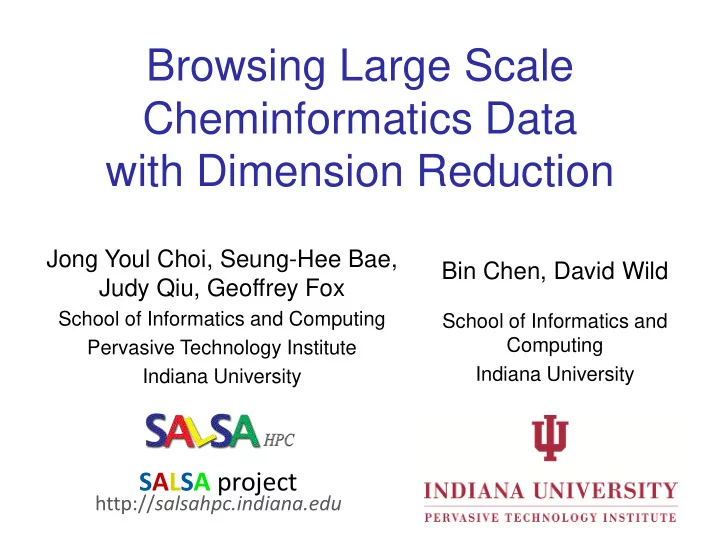

Browsing Large Scale Cheminformatics Data with Dimension Reduction Jong Youl Choi, Seung-Hee Bae, Bin Chen, David Wild Judy Qiu, Geoffrey Fox School of Informatics and Computing School of Informatics and Computing Pervasive Technology Institute Indiana University Indiana University SALSA project http:// salsahpc.indiana.edu
Drug Discovery Nature Reviews Drug Discovery 1, 515–528 (1 July 2002) ▸ A pipeline process with various stages – Many screening processes to filter out large number of chemical compounds – Empirical science 1
Data Mining for Drug Discovery ▸ Modern drug discovery – Not an empirical science anymore – Data intensive science – Use of in silico screening methods (Cresset’s FieldAlign, Nature, 2007) ▸ Numerous open databases – NIH founded PubChem – DrugBank, Comparative Toxicogenomics Database (CTD), … (Chem2Bio2RDF) 2
Motivation ▸ To browse large and high-dimensional data ➥ Data visualization by dimension reduction ➥ High-performance dimension reduction algorithms ▸ To utilize many open (value-added) data ➥ Combine data from different sources in one place ➥ A uniform interface ▸ A light-weight easy-to-use visualization tool ➥ A desktop client with an user-friendly UI ➥ Easy to use high-performance computing resources 3
PubChemBrowse System PubChemBrowse Light-weight client DrugBank CTD QSAR PubChem Visualization Chem2Bio2RDF Algorithms Parallel dimension Aggregated public reduction algorithms databases 4
Visualization by Dimension Reduction PubChem Data Low Dimensional Data High Dimensional Data (166 dimensions) ▸ Simplify data ▸ Preserve the original data’s information as much as possible in lower dimension ▸ Explore enormous data in 3D 5
Visualization Algorithms ▸ Compute- and memory-intensive algorithms – High-performance is not for free – Commodity hardware is not capable of processing large data ▸ In-house high-performance visualization algorithms – Parallel GTM (Generative Topographic Mapping) – Parallel MDS (Multi-dimensional Scaling) – Further performance improvement by interpolation extensions to GTM and MDS 6
GTM vs. MDS GTM MDS (SMACOF) • Non-linear dimension reduction • Find an optimal configuration in a lower-dimension Purpose • Iterative optimization method Vector-based data Non-vector (Pairwise similarity matrix) Input Objective Maximize Log-Likelihood Minimize STRESS or SSTRESS Function O(N 2 ) O(KN) (K << N) Complexity Optimization EM Iterative Majorization (EM-like) Method 7
Parallel GTM ▸ Finding K clusters for N data points Example: A 8-byte double – Relationship is a bipartite graph (bi-graph) precision matrix for N=100K and – Represented by K-by-N matrix (K << N) K=8K requires 6.4GB ▸ Decomposition for P-by-Q compute grid – Reduce memory requirement by 1/PQ A B C A 1 B 1 2 C 2 K latent N data points points 8
Parallel MDS Example: ▸ Decomposition for P-by-Q compute grid A 8-byte double precision matrix – Reduce memory requirement by 1/PQ for N=100K requires 80GB A B C A B C 9
Interpolation extension to GTM/MDS ▸ Full data processing by GTM or MDS is computing- and memory-intensive ▸ Two step procedure – Training : training by M samples out of N data – Interpolation : remaining (N-M) out-of-samples are approximated without training M Trained data Training In-sample Interpolated N-M Interpolation GTM/MDS Out-of-sample map Total N data 10
PubChemBrowse ▸ Light-weight desktop client ▸ Interactive user interface ▸ Display 3D embedding and meta data 11
Chem2Bio2RDF ▸ Value-added database of databases – Aggregate over 20 public databases (PubChem, CTD, DrugBank, … ) – Stored in RDF (Resource Description Framework) – Support SPARQL query language ▸ SPARQL query – A W3C standard query language for RDF PREFIX foaf: <http://xmlns.com/foaf/0.1/> SELECT ?name ?email ?name ?email WHERE { ?p ?per erson on a a foa oaf: f:Per erson son. . ?pe perso rson n foaf oaf:n :name ame ?na ?name. e. ?pe perso rson n foaf oaf:m :mbox box ?em ?email il. } 12
Query Interface 13
CTD data for gene-disease PubChem data with CTD visualization by using MDS (left) and GTM (right) About 930,000 chemical compounds are visualized as a point in 3D space, annotated by the related genes in Comparative Toxicogenomics Database (CTD) 14
Chem2Bio2RDF Chemical compounds shown in literatures, visualized by MDS (left) and GTM (right) Visualized 234,000 chemical compounds which may be related with a set of 5 genes of interest (ABCB1, CHRNB2, DRD2, ESR1, and F2) based on the dataset collected from major journal literatures which is also stored in Chem2Bio2RDF system. 15
Solvent screening Visualizing 215 solvents 215 solvents (colored and labeled) are embedded with 100,000 chemical compounds (colored in grey) in PubChem database 16
Conclusion ▸ Modern drug discovery – Data intensive process – High-throughput in silico screening methods ▸ PubChemBrowse – A light-weight desktop client – Parallel high-performance visualization algorithms – Access multiple databases via Chem2Bio2RDF by using an uniform interface, SPARQL query 17
Thank you Question? Email me at jychoi@cs.indiana.edu 18
Recommend
More recommend